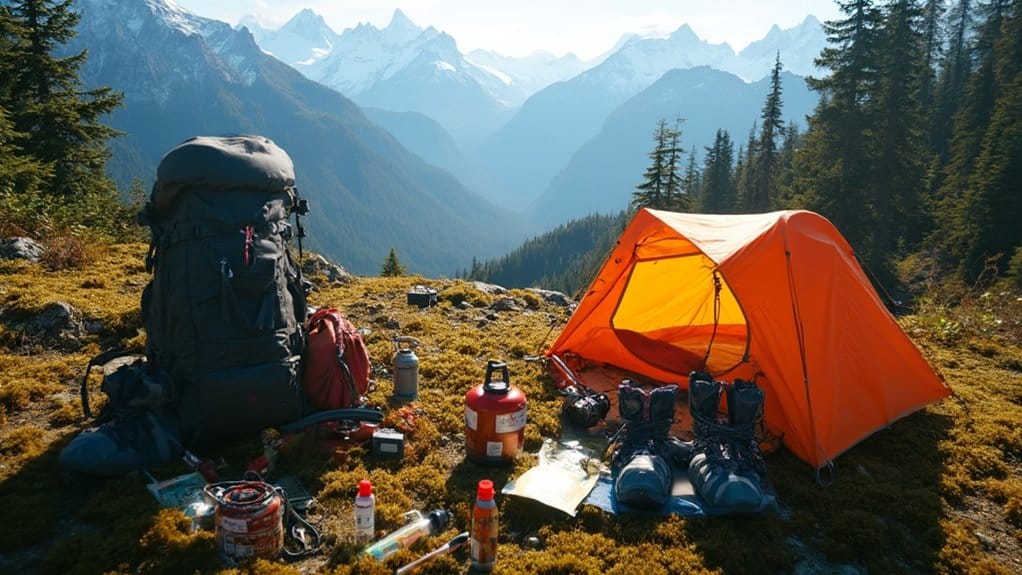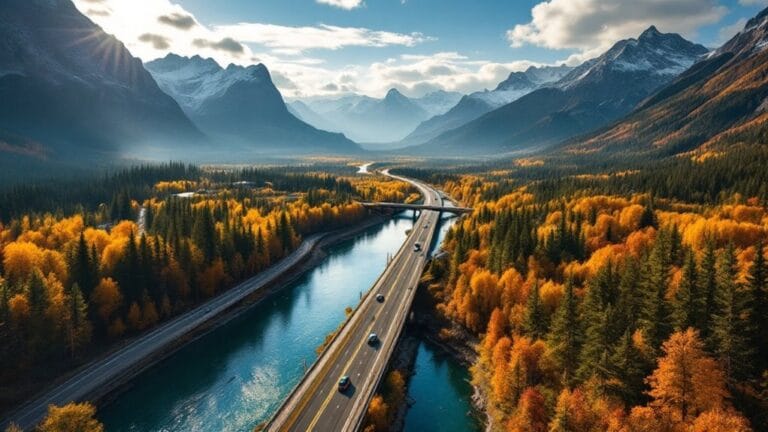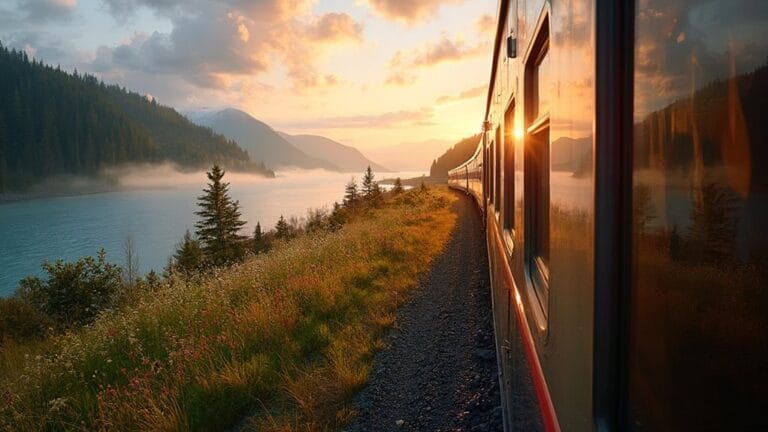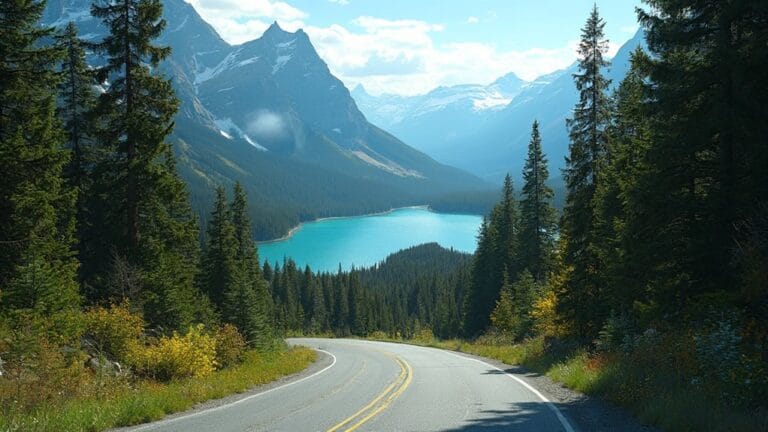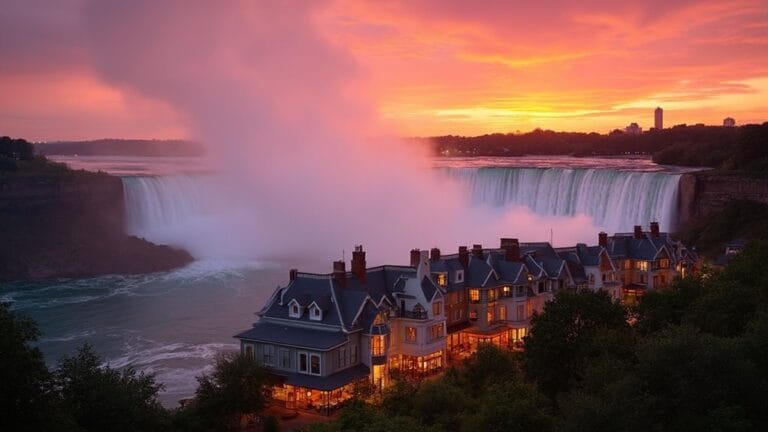Packing wisely for your Canadian backcountry adventure is a game changer! Think about it: you don't want a bear breaking into your food stash or getting lost because your phone's dead. With a first aid kit, bear-proof containers, and a trusty map, you're covering your bases. Snacks like peanut butter are your best friends, too—who doesn't love a tasty energy boost? Don't forget a good sleeping bag to snuggle up in at night! All this gear turns a potential disaster into an epic story to tell. Stick around, and you'll uncover even more essential items for a safe adventure!
Key Takeaways
- Packing safety gear like a first aid kit and a whistle ensures preparedness for emergencies and enhances overall safety in the wilderness.
- Utilizing wildlife safety measures, such as bear-proof containers and making noise, minimizes encounters with dangerous animals in their natural habitat.
- Navigation tools like maps and GPS devices are essential for staying on course and ensuring you can find your way back safely.
- Adequate food and hydration supplies, including water filters, provide necessary energy and prevent dehydration during physically demanding activities.
- Proper shelter and clothing gear protect against the elements, ensuring comfort and warmth, which are vital for survival in unpredictable Canadian weather.
Safety Essentials for Adventurers
When you venture into the Canadian backcountry, prioritizing safety essentials is crucial for a successful trip. First off, let's talk about injury prevention. You don't wanna be the one who trips over a root and ends up with a twisted ankle miles from help. Always carry a first aid kit to treat those pesky cuts or scrapes. And hey, sharing your itinerary with a friend or family member is a smart move—they'll know where to start looking if things go south.
Now, wildlife safety is a biggie. Imagine stumbling upon a bear while hiking; you'd want to be prepared! Use bear-proof containers for your food and avoid leaving scents behind. Staying aware of your surroundings and making noise can often keep those furry friends at bay. Plus, it's always wise to learn how to react in case you do encounter wildlife—running isn't usually the best option!
Lastly, don't forget about navigation tools like maps and a GPS. They're your lifeline if you get lost. Having a good quality compass is also essential for route planning and ensuring you stay on track. With these safety essentials in tow, you'll not only enjoy your adventure but also return home with stories, instead of injuries or wildlife encounters gone wrong!
Gear and Equipment Must-Haves
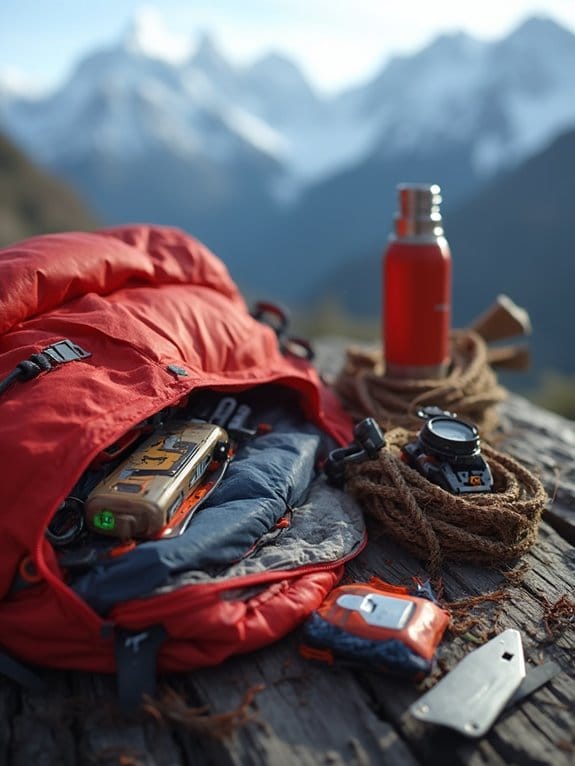
Packing for a Canadian backcountry adventure isn't just about safety; having the right gear and equipment can make all the difference in your experience. You'll want to start with navigation tools like a map, compass, and a GPS device. Trust me, getting lost isn't fun, and these items can be lifesavers. Communication devices, like 2-way radios or a Garmin inReach, are essential too. It's good to have a fully charged phone in a waterproof case, just in case.
Next up is lighting and fire starting. A reliable headlamp with extra batteries can turn a dark campsite into a cozy haven, while waterproof matches and a fire starting kit will help you roast marshmallows in no time. Don't forget an emergency shelter like a space blanket; it's lightweight and could save your life. Winter trails require proper equipment, so ensure you have the right gear for the season.
When it comes to food and water, pack extra snacks and a purification filter. A well-organized gear bag keeps everything in its place, which is vital for a smooth trip. And remember, a first aid kit is a must. With the right gear, you'll tackle any backcountry adventure like a pro!
Clothing and Insulation Tips
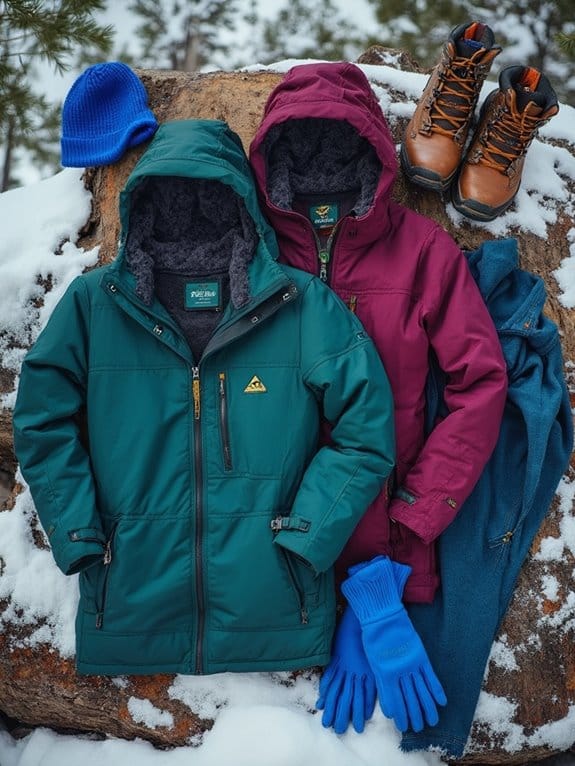
In the unpredictable Canadian backcountry, layering your clothing is key to staying warm and comfortable. Think of it like a cozy lasagna: you've got your base, middle, and outer layers. Start with a moisture-wicking base layer made from materials like merino wool or polyester. These will keep you dry by whisking away sweat—trust me, you don't want to be wet and cold out there!
Next up, your middle layer should focus on insulation materials like fleece or wool. These retain body heat while still allowing you to move freely, which is super important when you're hiking. Dressing appropriately reduces the risk of frostbite and hypothermia, so make sure to pack those extra layers. Finally, don't skimp on your outer layer. A good waterproof and windproof jacket is essential, especially if Mother Nature throws a tantrum. Look for features like sealed seams and an insulated hood to keep the chill at bay.
Oh, and please, for the love of warmth, avoid cotton! It turns into a soggy sponge when wet. So pack a warm hat, gloves, and extra socks, and you'll be ready to tackle whatever the backcountry throws your way!
Food and Hydration Strategies
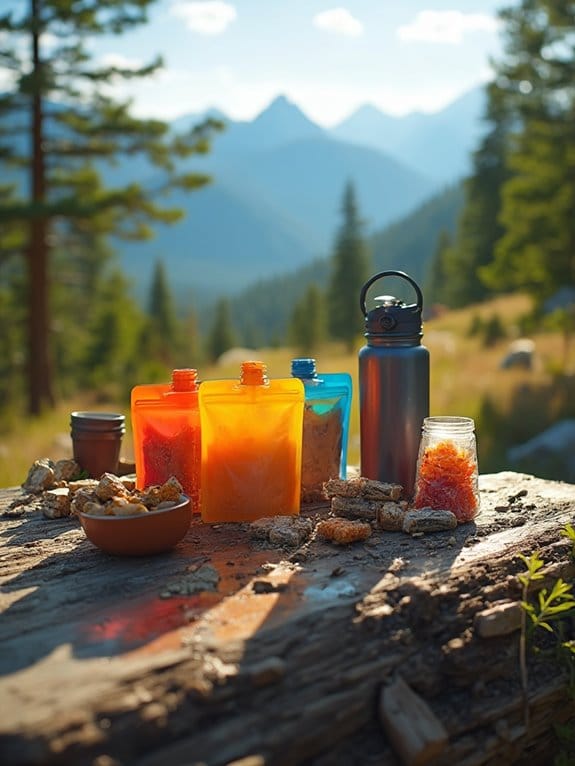
Food and hydration are essential components of any Canadian backcountry adventure. When you're out there, you'll want to pack dehydrated meals that are light and easy to prepare. Think instant rice, potatoes, or soups—mix them with your dehydrated ingredients for quick, hearty meals. But don't forget some non-dehydrated items, like peanut butter and honey for lunches, or fresh bacon and eggs to kick off your trip. Just skip the dairy unless you've got powdered options; spoilage is a real concern! Additionally, incorporating dehydrated fruits into your meals provides a flavorful and nutritious boost.
Now, let's talk hydration techniques. Start your day by chugging at least half a liter of water—trust me, it sets you up for success. Always scope out reliable water sources, even if they look dry at first; a good vantage point can save you a trek. And remember, when water looks questionable, a pre-filter and boiling will be your best friends. Don't forget to reassess your water needs as you go, and avoid the peak sun hours to keep your supply safe. Keeping hydrated is just as important as your food strategy, so don't let that slip!
Emergency and Repair Supplies
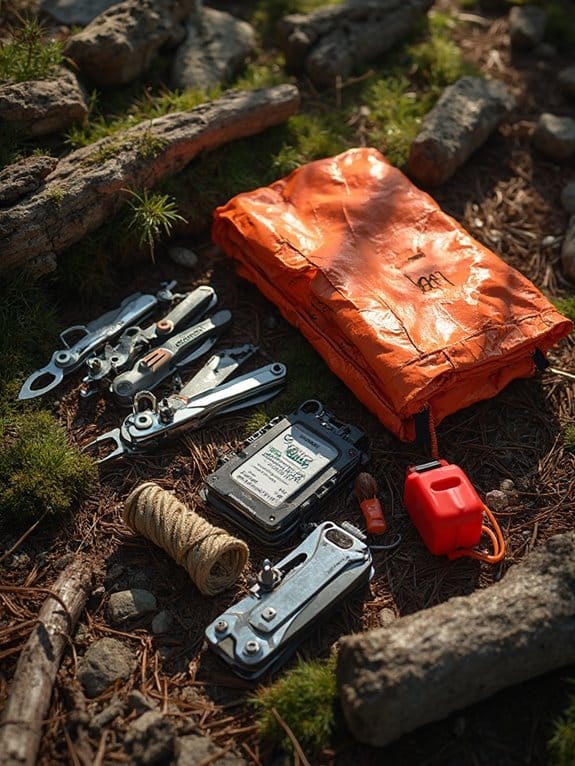
When heading into the Canadian backcountry, having the right emergency and repair supplies can make all the difference. Imagine this: you're miles away from civilization, and a sudden storm rolls in. An ultralight tarp or a bivvy sack can provide you with that essential dry and warm shelter. Don't forget an emergency space blanket or even a large plastic trash bag for extra protection.
Now, let's talk first-aid supplies. Tailor your kit to your group size and trip duration—think pocket CPR masks, trauma shears, and a handful of alcohol prep pads. You'll want to be ready for everything from blisters to small burns.
And when it comes to repair techniques, you can't overlook duct tape and paracord. They're lifesavers! A multitool with pliers and some extra batteries can fix just about anything. If you're hitting the slopes, don't forget specific items like ski straps and epoxy for binding repairs. Experienced guides like Joey Thompson emphasize the necessity of these tools to ensure you are prepared for any situation.
Finally, grab a good headlamp and a whistle. You'll be glad you did when you need to signal for help or just find your way in the dark. Trust me, being prepared can turn a potential disaster into just another adventure!
Navigation and Planning Tools
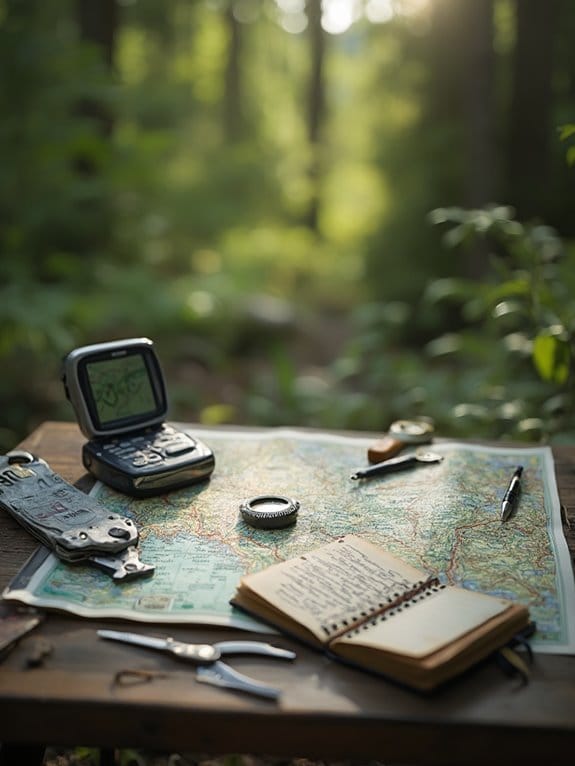
Steering through the vast Canadian backcountry requires more than just a sense of adventure; you'll need reliable tools to guide your journey. Think about it—getting lost among towering trees and rugged mountains isn't the ideal way to spend your trip! That's where navigation and planning tools come in.
Apps like Gaia GPS and Avenza Maps are game-changers, allowing for offline navigation so you can ditch the cell signal stress. Gaia GPS offers a range of maps, perfect for layering your route over topographic or satellite views. If you're feeling fancy, Caltopo lets you dive deep into map layering, helping you visualize your trek like a pro. Plus, you can import Caltopo maps into Avenza for offline use, which is super handy when you're out in the wild. Caltopo is a core tool for backcountry trip planning, making it essential for serious adventurers.
Don't forget some traditional navigational skills, either! A trusty map and compass can save the day when tech decides to take a vacation. So, whether you're customizing your route or just trying to find the nearest lake, these tools will keep you on the right track, ensuring your backcountry adventure is unforgettable—just hopefully not for the wrong reasons!
Frequently Asked Questions
What Are the Best Practices for Packing My Backpack Efficiently?
When you're packing your backpack, remember efficient packing techniques and weight distribution. Lay out your gear, use packing cubes, and prioritize essentials to maximize space and keep your load balanced for a comfortable journey.
How Do I Choose the Right Avalanche Gear for My Skill Level?
When choosing avalanche gear for your skill level, prioritize essentials for safety. Beginners should focus on basic gear, while experienced users can add advanced tools. Always guarantee you know how to use your equipment effectively.
What Should I Do if I Encounter Wildlife in the Backcountry?
When you encounter wildlife, it can feel like facing a roaring lion! Follow safety protocols: make noise, keep your distance, avoid eye contact, and know how to react to guarantee a safe wildlife encounter.
How Can I Ensure My Food Stays Fresh During Multi-Day Trips?
To guarantee your food stays fresh during multi-day trips, focus on meal planning and food preservation techniques. Use insulated containers, pack meals in order of perishability, and maintain proper temperatures to prevent spoilage.
What Are the Signs of Hypothermia I Should Look Out For?
You should be aware of hypothermia symptoms like shivering and confusion. Recognizing these signs early can help you implement effective prevention strategies, ensuring your safety during cold weather excursions. Stay alert and prepared!

